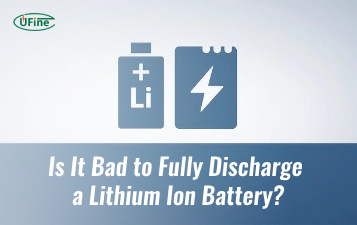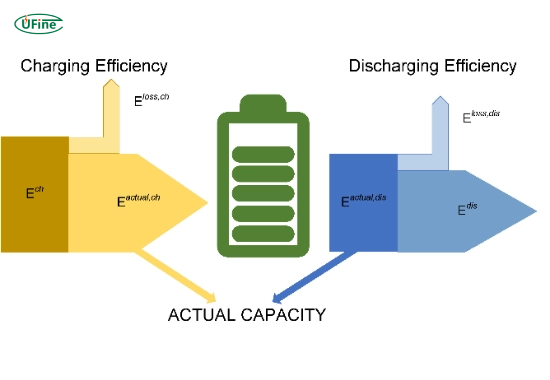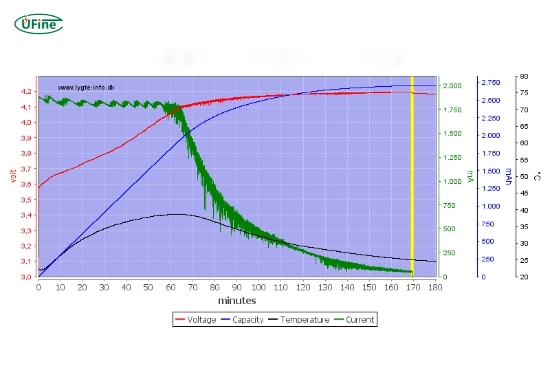
- Part 1. What is battery maximum capacity?
- Part 2. What is battery maximum capacity in lithium cells?
- Part 3. Why is battery maximum capacity critical in lithium battery manufacturing?
- Part 4. What causes lithium battery capacity to degrade?
- Part 5. How do manufacturers measure and validate battery maximum capacity?
- Part 6. How does temperature affect lithium-ion battery degradation?
- Part 7. How is battery maximum capacity used in battery management systems (BMS)?
- Part 8. What is the difference between design capacity and maximum capacity?
- Part 9. How do different chemistries affect maximum capacity?
- Part 10. How do manufacturers extend the usable maximum capacity?
- Part 11. How does cycle life relate to maximum capacity?
- Part 12. FAQs about battery maximum capacity
Battery maximum capacity is foundational in lithium-ion cell design, manufacturing, and application. At the core of every battery-powered system—an electric vehicle, energy storage unit, or industrial equipment—lies the question: How much energy can this battery store and deliver reliably over time?
Part 1. What is battery maximum capacity?
Battery maximum capacity refers to the total energy a lithium-ion battery can store when fully charged and in optimal condition. Depending on the application, it is typically measured in watt-hours (Wh) or ampere-hours (Ah).
This figure represents how much energy a battery cell can supply from 100% to 0% state of charge (SOC) under standard conditions. It is one of the most critical metrics in battery engineering. Manufacturers, system designers, and end-users use it to determine performance, runtime, and operational efficiency.
Part 2. What is battery maximum capacity in lithium cells?
In lithium-ion cells, maximum capacity is not just a number on a spec sheet—it defines the core energy potential of the cell. It is determined through laboratory testing under optimal environmental conditions, typically:
- Ambient temperature of 25°C (77°F)
- Standard charging and discharging rates (C-rates)
- Full charge to full discharge cycles (0% to 100% SOC)
Battery maximum capacity is recorded at the beginning of the life (BoL) of the cell. As the battery ages, this capacity declines—a process known as capacity fade or degradation.
Part 3. Why is battery maximum capacity critical in lithium battery manufacturing?
For battery manufacturers, understanding and optimizing maximum capacity is essential for several reasons:
- Product Specification: It defines the energy storage claim on datasheets.
- Customer Trust: Accurate capacity ratings ensure customers receive what is advertised.
- System Integration: Engineers use maximum capacity to size battery packs for EVs, UPS systems, or renewable energy storage.
- Lifecycle Planning: Knowing how much capacity will fade over time helps forecast replacement cycles.
A lithium battery with a higher maximum capacity can deliver more power over longer durations, which is vital for competitive advantage.
Part 4. What causes lithium battery capacity to degrade?
Lithium-ion batteries degrade over time due to chemical, mechanical, and environmental factors. The most common causes of capacity loss include:
- SEI layer growth: The Solid Electrolyte Interphase (SEI) forms during the first few charging cycles. Over time, this layer thickens, consuming lithium ions and reducing capacity.
- Lithium plating: Fast or low-temperature charging can cause lithium to plate onto the anode, making it unavailable for energy storage.
- Electrolyte decomposition: As the electrolyte degrades, it reduces ion mobility and increases internal resistance.
- Structural damage: Repeated cycling causes electrodes to expand and contract, leading to micro-cracks and the loss of conductive pathways.
Part 5. How do manufacturers measure and validate battery maximum capacity?
In a manufacturing or R&D environment, battery maximum capacity is determined through controlled testing using battery cyclers and diagnostic tools. The process typically involves:
- Formation cycles: Initial charge/discharge cycles to stabilize the cell.
- Capacity test: A full charge followed by a constant current discharge at a standard C-rate (e.g., 0.5C or 1C) until voltage cut-off.
- Measurement tools: Precision equipment records the total ampere-hours or watt-hours released during discharge.
These tests are often repeated under varying conditions to obtain temperature profiles, cycle life data, and aging curves.
Part 6. How does temperature affect lithium-ion battery degradation?
Temperature is one of the most critical factors affecting the performance and lifespan of lithium-ion cells. High and low temperatures can significantly impact battery maximum capacity and overall health.
High temperatures (above 35°C / 95°F)
- Accelerated SEI growth: Higher temperatures increase the rate of SEI layer thickening, leading to faster lithium consumption.
- Electrolyte breakdown: Heat can cause the electrolyte to decompose, producing gases and increasing internal resistance.
- Thermal runaway risk: Prolonged exposure may lead to exothermic reactions, swelling, or even fire.
- Increased self-discharge: Cells lose charge more quickly, reducing usable capacity.
Low temperatures (below 0°C / 32°F)
- Slower ion movement: Cold slows down lithium-ion transport, reducing available capacity during discharge.
- Lithium plating: Charging in cold conditions can cause metallic lithium to deposit on the anode, permanently degrading capacity.
- Increased impedance: Electrochemical reactions are less efficient, leading to voltage drops and power loss.
Optimal temperature range
To maintain maximum capacity and long cycle life, lithium-ion batteries should ideally operate in the range of 15°C to 30°C (59°F to 86°F).
Part 7. How is battery maximum capacity used in battery management systems (BMS)?
A Battery Management System (BMS) is the brain of a lithium battery pack. It constantly monitors and manages the battery’s health, safety, and performance.
The BMS uses maximum capacity data to:
- Calculate the State of Charge (SOC) and State of Health (SOH)
- Control charging and discharging to prevent overuse
- Balance cells in multi-cell configurations
- Predict remaining useful life (RUL)
Accuracy in maximum capacity measurement allows the BMS to provide precise runtime estimations, optimize energy usage, and extend battery lifespan.
Part 8. What is the difference between design capacity and maximum capacity?
These two terms are often confused but serve different purposes:
- Design Capacity: A battery’s theoretical capacity is designed to store when new.
- Maximum Capacity: The actual capacity the battery can store at any given time.
As batteries age, maximum capacity decreases, diverging from the design capacity. This gap is a key metric in evaluating battery health and aging.
Part 9. How do different chemistries affect maximum capacity?
Not all lithium-ion chemistries deliver the same maximum capacity. Here’s a comparison:
| Chemistry | Nominal Voltage | Gravimetric Energy Density (Wh/kg) | Cycle Life (80% capacity) | Thermal Stability |
|---|---|---|---|---|
| NMC (Nickel Manganese Cobalt) | 3.6–3.7V | 150–220 | 1000–2000 | Medium |
| LFP (Lithium Iron Phosphate) | 3.2V | 90–160 | 2000–6000 | Very High |
| NCA (Nickel Cobalt Aluminum) | 3.6V | 200–260 | 1000–2000 | Medium |
| LCO (Lithium Cobalt Oxide) | 3.7V | 150–200 | 300–800 | Low |
Depending on the application, manufacturers must balance maximum capacity, cycle life, and thermal stability.
Part 10. How do manufacturers extend the usable maximum capacity?
Manufacturers use several techniques to optimize and preserve battery maximum capacity:
- Advanced cell design: Use of high-purity materials and optimized electrode structures.
- Protective coatings: Prevent degradation of electrode surfaces.
- Thermal management systems: Integrate cooling or heating to maintain optimal temperature.
- Innovative charging protocols: Adaptive charging speeds based on temperature and SOC.
- Cell balancing: Ensures uniform aging across all cells in a pack.
These strategies help reduce capacity fade and extend the battery’s useful life.
Part 11. How does cycle life relate to maximum capacity?
Cycle life refers to the number of charge/discharge cycles a battery can complete before its maximum capacity falls below a certain threshold—usually 80% of its original value.
For example:
- An NMC battery rated for 1,000 cycles may retain 80% capacity after 1,000 full charge/discharge cycles.
- A high-quality LFP battery can maintain 80% capacity after 2,000–3,000 cycles.
Accurately predicting and monitoring maximum capacity is essential for determining warranty periods, maintenance schedules, and total cost of ownership.
Part 12. FAQs about battery maximum capacity
What is considered a healthy maximum capacity for a lithium battery?
A healthy battery should retain at least 80% of its original maximum capacity after 500–1000 cycles, depending on the chemistry and usage conditions.
Can battery capacity be recovered after degradation?
No. Degraded capacity is permanent. While calibration may help the BMS report be more accurate, energy storage cannot be restored.
How does fast charging impact maximum capacity?
Fast charging generates more heat and can cause lithium plating, accelerating capacity loss. Manufacturers often limit charging speed to protect the battery.
Can batteries be designed for a higher maximum capacity?
Yes. Manufacturers can design cells with higher maximum capacity using higher energy density materials, larger form factors, or multi-layer electrodes. However, this often involves trade-offs in safety and lifespan.
Why do two identical lithium batteries show different maximum capacities?
Variations in manufacturing tolerances, usage patterns, and thermal exposure can lead to different aging rates, even among identical cells.
Related Tags:
More Articles

Is It Bad to Fully Discharge a Lithium Ion Battery?
Discover what happens if a lithium battery is fully discharged and how to safely recharge 12V batteries to prevent permanent damage.
Does a Higher mAh Battery Last Longer?
Does a higher mAh battery really last longer? Learn what mAh means, real battery life in hours, replacement safety (4000 vs 5000mAh), and real examples.
Exploring the Lithium Ion Battery Fire Temperature
Discover the lithium-ion battery fire temperature and learn how to stay safe. Get essential tips to prevent battery fires and protect your devices today.
The Ultimate Guide to 6s Lipo Batteries
A beginner-friendly guide to 6S LiPo batteries. Understand voltage, capacity, charging tips, safety rules, and real-world applications.
What is the NCMA battery? What is the difference between it and the NMC battery? Which one is better? This article will answer your questions.




